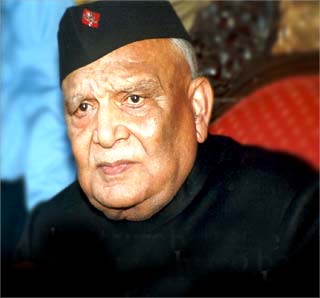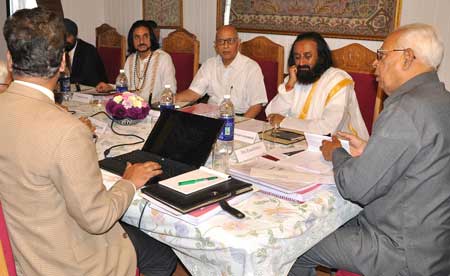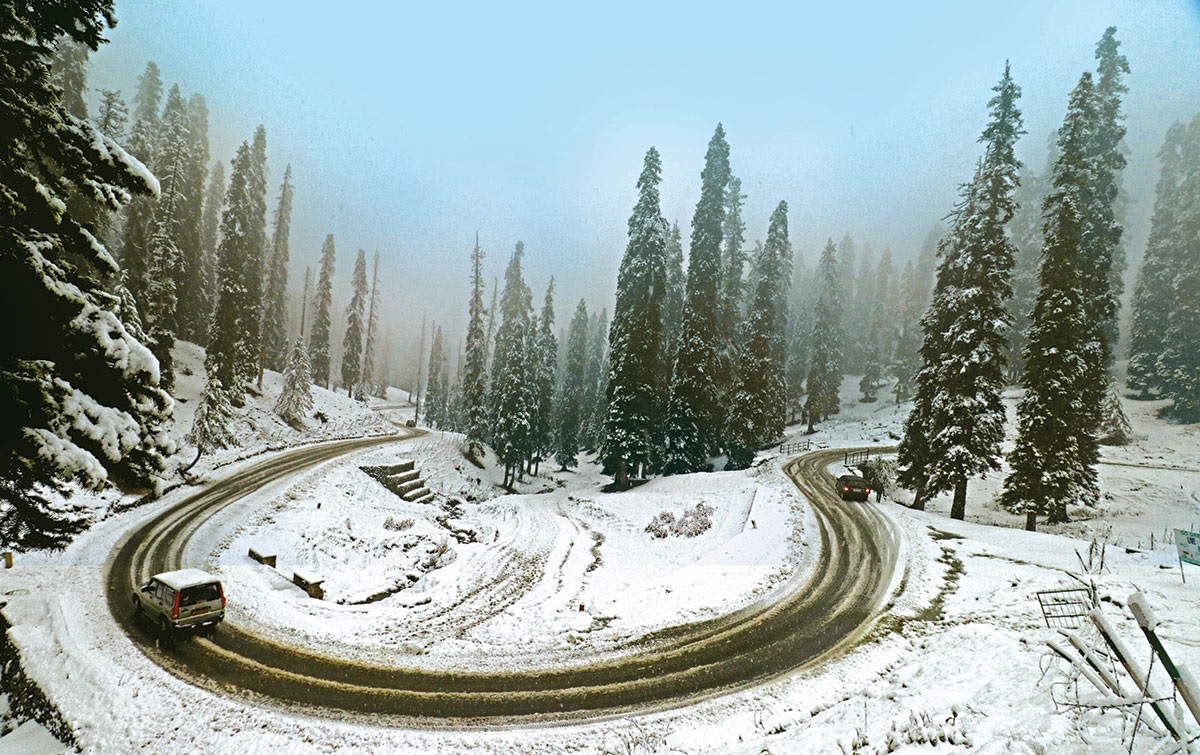Along two difficult mountain trek routes, from security to availability of food, medicines and warm shelter, SASB and numerous state government agencies manage everything during the annual Hindu pilgrimage to the cave shrine of Amarnath. But it is only a cool and clean environment that can slow down fast melting away of the ice lingham, a Kashmir Life analysis.

The ice Lingham, phallic symbol of the Hindu god Shiva that forms inside the cave shrine, is the main attraction for tens of thousands of pilgrims who visit Amarnath every year in the Kashmir Himalayas. But not every pilgrim gets a glimpse of it after traveling hundreds of kilometers and a grueling trek for faith. The ice lingam melts away within a couple of weeks forcing many pilgrims to go back without a glimpse.
The ‘vanishing act’ of the lingham has remained a major problem for the Shri Amarnathji Shrine Board (SASB) because early melting away of the stalagmite essentially means diminishing interest in pilgrims and a reduction in the footfalls to the cave, located over 13,000 ft above sea level. Formation of the stalagmite is a natural process of glacial melt dripping into the freezing cave. A rush of pilgrims pushes the temperature up around the cave environs. But that is where a predicament for the SASB that intends to keep on the flow of pilgrims going up to the cave for the entire yatra period of two months.
The issue has become almost an annual crisis. Once, the lingham was found melted away the very day the yatra begun. In 2004 barely within 12 days after the yatra officially commenced, it almost gone. It has been happening almost every year as the soaring mercury takes its toll on the lingam. Even this year it has substantially reduced in length and girth even as the pilgrimage is midway on. By and large the fully formed 12 ft lingham takes barely two to three weeks to completely vanish.
In 2006, the lingham was not formed at all. The teams that reached the cave in advance were surprised to see a lot of snow in the cave instead of an ice lingham. It was at the peak of this crisis that Times of India ran a front page story accusing SASB of implanting a fake Shivalingham. It traced certain SASB communications suggesting the Board procured a ton of dry ice from Delhi. All hell broke loose. The arrivals stopped and people in Delhi started thinking of replacing the board chairman and the then governor Lt Gen (retd) S K Sinha.
The SASB reacted cautiously. It announced a probe by a retired high court judge Justice K K Gupta. Nobody noticed that the board accused of fraud, appointed the Commission. This led to the resignation of Mahant Deependera Giri as member of the SASB. Giri had sought Sinha’s ouster for fiddling with Hindu faith and committing a sacrilegious act.
Gupta absolved the SASB of all charges. A year later, SASB admitted that given the late formation of the lingham and its small size, bags of dry ice were obtained to be placed at the mouth of the cave to keep the temperature down for the lingam’s longevity.
 But the soaring temperatures are not the only factor responsible for ‘early’ melting away of the lingham. Preliminary studies carried out on SASB request by the army’s High Altitude Warfare School or HAWS and Snow and Avalanche Studies Establishment (SASE) suggested that the fast meltdown is caused by ambient temperatures and emission of human energy near the cave. Apart from ventilation load of 36 kilo-watts, every single pilgrim emits 100 watts energy while worshiping inside the cave. At any point in time there is an average of 200 pilgrims inside the cave which means 20 kilo watts of heat being generated.
But the soaring temperatures are not the only factor responsible for ‘early’ melting away of the lingham. Preliminary studies carried out on SASB request by the army’s High Altitude Warfare School or HAWS and Snow and Avalanche Studies Establishment (SASE) suggested that the fast meltdown is caused by ambient temperatures and emission of human energy near the cave. Apart from ventilation load of 36 kilo-watts, every single pilgrim emits 100 watts energy while worshiping inside the cave. At any point in time there is an average of 200 pilgrims inside the cave which means 20 kilo watts of heat being generated.
The SASB studies identified a series of activities that accelerate the melting process. These included the use of cameras, flash bulbs and other inflammable puja material like burning of incense sticks. At one point of time, six choppers flying from Pahalgam and Baltal would land near the staircase to the cave. Later, the operation of the private careers was shifted to a different place and flying of choppers over the cave was banned. But even SASB itself is a contributor ambient temperature rising.
It is installing gas geysers all along the twin tracks for the pilgrims adding to the overall ambient temperature.
For many years the SASB and the state government were permitting ‘service yatra’ meant for families of security forces’ officials. They would be allowed to hit the shrine10-15 days ahead of the formal start of the yatra and have special puja sessions inside the cave. Bajrang Dal in 2007 questioned SASB wisdom of permitting influential and rich people in ahead of the formal start of the pilgrimage, some of whom were filmed embracing the lingham causing early start of the melt away.

In 2008, when J&K was grappling with the crisis triggered by the controversial allotment of land to the SASB, the rescinding of which later cost Ghulam Nabi Azad his government, SASB was busy in another battle. As the lingham had melted away, Bolay Nath Seva Samiti (BNSS) provided it a huge marble Shivlingham that it wanted to be installed at the gate of the cave. BNSS is a committee that manages one of the langhars (community kitchens) during the yatra. Thousands of BNSS members had brought an 800-kg and 6-feet-high transparent marble form of the lingam from Udaipur (Rajasthan) sculpted over a fortnight by master craftsmen. They approached the SASB with it and met with no objection.
But a group of Kashmiri Pandits petitioned the court and sought a stay order. They termed the idea of installing marble at the cave shrine sacrilegious. Nobody knows what happened to the BNSS idea afterwards.
It was in May 2004 that SASB made it public that it is working since 2000, the very day it was constituted, to extend the life of the ice stalagmite. Defence Research and Development Organization (DRDO) and IIT Mumbai were the two main organizations that were approached by the SASB for this purpose.
“We actually do not want to interfere in the formation of the lingam,” Dr Arun Kumar, the then controversial CEO of SASB told reporters. “We just want to see it prolongs till the yatra concludes. Prof Malind Ray of IIT Mumbai has actually designed a scheme that he calls Radiant Cooling Penal. It is no refrigeration but it manages the heat load that is formed in the cave.” Well before the half a million rupees worth of the system would be put to test on experimental basis, it ended up in litigation.

The SASB explained it later in 2007 in wake of controversies involved around the fast melting away lingam. “The SASB has been gravely concerned about this matter and wants to provide greater yatra satisfaction to the pilgrims by ensuring that the lingam remains intact,” SASB spokesman said, adding various options were explored. These included adopting the ice skating rink technique, refrigeration inside the cave, putting frozen brine trays, air curtain, and radiant cooling panels. Apart from discussing at various Board meetings, experiments were carried out at Mumbai, Srinagar and Gulmarg.
“It was felt that radiant cooling panels provided the best option but the division bench of the High Court ordered a stay on the use of these panels,” the spokesman said. The formation or melting of the lingam, the spokesman explained, is primarily connected with natural phenomenon like global warming, shifting of glaciers as revealed by satellite pictures taken in 2006 and earthquake of 2005 which may have affected the seeping of water from the glaciers to the cave through layers of rocks. It is the cumulative effect of all these factors besides the body heat of pilgrims paying obeisance at the cave which lead to the faster melting of the lingam.
In fact all the 60 glaciers on the twin tracks leading to the cave shrine are receding. These include the one that feeds the cave which had shrunken by 100 meters in 2007 alone.
Technology might be of some help to keep the ‘ice-deity’ intact for longer, but the survival of the yearly pilgrimage is intimately linked to the fragility of ecology. If it retains a sub-celsius temperature, the lingham forms and stays. If it is hotter, it barely forms and melts away soon.
The dictum that survived all histories and covenants is that faith falters when it clashes with nature. Together they survive longer.















